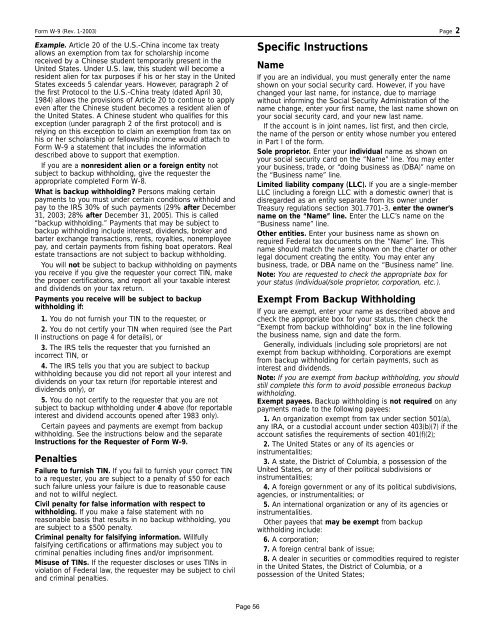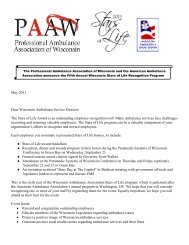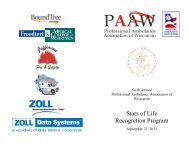Wisconsin In-Network Transportation Provider Checklist
Wisconsin In-Network Transportation Provider Checklist
Wisconsin In-Network Transportation Provider Checklist
Create successful ePaper yourself
Turn your PDF publications into a flip-book with our unique Google optimized e-Paper software.
Form W-9 (Rev. 1-2003) Page 2Example. Article 20 of the U.S.-China income tax treatyallows an exemption from tax for scholarship incomereceived by a Chinese student temporarily present in theUnited States. Under U.S. law, this student will become aresident alien for tax purposes if his or her stay in the UnitedStates exceeds 5 calendar years. However, paragraph 2 ofthe first Protocol to the U.S.-China treaty (dated April 30,1984) allows the provisions of Article 20 to continue to applyeven after the Chinese student becomes a resident alien ofthe United States. A Chinese student who qualifies for thisexception (under paragraph 2 of the first protocol) and isrelying on this exception to claim an exemption from tax onhis or her scholarship or fellowship income would attach toForm W-9 a statement that includes the informationdescribed above to support that exemption.If you are a nonresident alien or a foreign entity notsubject to backup withholding, give the requester theappropriate completed Form W-8.What is backup withholding? Persons making certainpayments to you must under certain conditions withhold andpay to the IRS 30% of such payments (29% after December31, 2003; 28% after December 31, 2005). This is called“backup withholding.” Payments that may be subject tobackup withholding include interest, dividends, broker andbarter exchange transactions, rents, royalties, nonemployeepay, and certain payments from fishing boat operators. Realestate transactions are not subject to backup withholding.You will not be subject to backup withholding on paymentsyou receive if you give the requester your correct TIN, makethe proper certifications, and report all your taxable interestand dividends on your tax return.Payments you receive will be subject to backupwithholding if:1. You do not furnish your TIN to the requester, or2. You do not certify your TIN when required (see the PartII instructions on page 4 for details), or3. The IRS tells the requester that you furnished anincorrect TIN, or4. The IRS tells you that you are subject to backupwithholding because you did not report all your interest anddividends on your tax return (for reportable interest anddividends only), or5. You do not certify to the requester that you are notsubject to backup withholding under 4 above (for reportableinterest and dividend accounts opened after 1983 only).Certain payees and payments are exempt from backupwithholding. See the instructions below and the separate<strong>In</strong>structions for the Requester of Form W-9.PenaltiesFailure to furnish TIN. If you fail to furnish your correct TINto a requester, you are subject to a penalty of $50 for eachsuch failure unless your failure is due to reasonable causeand not to willful neglect.Civil penalty for false information with respect towithholding. If you make a false statement with noreasonable basis that results in no backup withholding, youare subject to a $500 penalty.Criminal penalty for falsifying information. Willfullyfalsifying certifications or affirmations may subject you tocriminal penalties including fines and/or imprisonment.Misuse of TINs. If the requester discloses or uses TINs inviolation of Federal law, the requester may be subject to civiland criminal penalties.Specific <strong>In</strong>structionsNameIf you are an individual, you must generally enter the nameshown on your social security card. However, if you havechanged your last name, for instance, due to marriagewithout informing the Social Security Administration of thename change, enter your first name, the last name shown onyour social security card, and your new last name.If the account is in joint names, list first, and then circle,the name of the person or entity whose number you enteredin Part I of the form.Sole proprietor. Enter your individual name as shown onyour social security card on the “Name” line. You may enteryour business, trade, or “doing business as (DBA)” name onthe “Business name” line.Limited liability company (LLC). If you are a single-memberLLC (including a foreign LLC with a domestic owner) that isdisregarded as an entity separate from its owner underTreasury regulations section 301.7701-3, enter the owner’sname on the “Name” line. Enter the LLC’s name on the“Business name” line.Other entities. Enter your business name as shown onrequired Federal tax documents on the “Name” line. Thisname should match the name shown on the charter or otherlegal document creating the entity. You may enter anybusiness, trade, or DBA name on the “Business name” line.Note: You are requested to check the appropriate box foryour status (individual/sole proprietor, corporation, etc. ).Exempt From Backup WithholdingIf you are exempt, enter your name as described above andcheck the appropriate box for your status, then check the“Exempt from backup withholding” box in the line followingthe business name, sign and date the form.Generally, individuals (including sole proprietors) are notexempt from backup withholding. Corporations are exemptfrom backup withholding for certain payments, such asinterest and dividends.Note: If you are exempt from backup withholding, you shouldstill complete this form to avoid possible erroneous backupwithholding.Exempt payees. Backup withholding is not required on anypayments made to the following payees:1. An organization exempt from tax under section 501(a),any IRA, or a custodial account under section 403(b)(7) if theaccount satisfies the requirements of section 401(f)(2);2. The United States or any of its agencies orinstrumentalities;3. A state, the District of Columbia, a possession of theUnited States, or any of their political subdivisions orinstrumentalities;4. A foreign government or any of its political subdivisions,agencies, or instrumentalities; or5. An international organization or any of its agencies orinstrumentalities.Other payees that may be exempt from backupwithholding include:6. A corporation;7. A foreign central bank of issue;8. A dealer in securities or commodities required to registerin the United States, the District of Columbia, or apossession of the United States;Page 56





